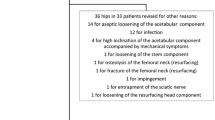Abstract
High blood metal levels have been described in the past, primarily in metal-on-metal bearings. Other possible causes are often underestimated. This report presents the case of a 70-year-old female patient who suffered from pronounced neurological symptoms (especially fatigue and concentration problems) 13 years after implantation of a hip endoprosthesis with metal-polyethylene (ME-PE) bearing. An osteolysis in the pelvis and loosening of the acetabular component were detected. In addition, large quantities of metallic black discolored granulomas were detected in the periarticular environment during surgery. A ventral impingement with destruction of the titanium cup and the PE insert was identified as the suspected cause of this condition. The postoperative course of the blood metal levels was unexpected as titanium levels increased massively in the blood. Anamnesis, course of the disease and the surgical procedure as well as especially the course of the metal values in the blood of the patient are presented. Possible causes for the excessive occurrence of metal abrasion, the systemic distribution and potential toxic effects of titanium are explained and discussed in detail. In addition, the currently available literature on the subject is critically examined.
Zusammenfassung
Hohe Metallwertkonzentrationen im Blut wurden in der Vergangenheit insbesondere bei Metall-Metall-Gleitpaarungen beschrieben. Andere mögliche Ursachen werden bisher mitunter unterschätzt. Diese Kasuistik behandelt den Fall einer 70-jährigen Patientin die 13 Jahre nach Implantation einer Hüftendoprothese mit Metall-Polyethylen(ME-PE)-Gleitpaarung unter ausgeprägten neurologischen Symptomen (insbesondere Antriebslosigkeit und Konzentrationsschwäche) litt. Im Becken ließen sich große Osteolysen sowie eine Lockerung der Pfanne nachweisen. Zudem waren intraoperativ große Mengen an metallisch-schwarz verfärbten Granulomen periartikulär nachweisbar. Als vermutliche Ursache wurde ein ventrales Impingement mit Destruktion der ventralen Anteile der Titanpfanne sowie des PE-Inserts ausgemacht. Unerwartet war der postoperative Verlauf der Metallwerte mit einem massiven Anstieg der Titanwerte im Blut. Vorgestellt werden Anamnese, Krankheitsverlauf, das operative Vorgehen sowie insbesondere der Verlauf der Metallwerte im Blut der Patientin. Mögliche Ursachen für den ausgeprägten Anfall an Metallabrieb, dessen systemische Verteilung sowie mögliche toxische Effekte von Titan werden ausführlich erläutert und diskutiert. Zudem wird die aktuell verfügbare Literatur zur Thematik kritisch beleuchtet.





Similar content being viewed by others
Abbreviations
- Co:
-
Cobalt
- Cr:
-
Chromium
- ICP-MS:
-
inductively coupled plasma mass spectrometry
- ME:
-
Metal
- Ni:
-
Nickel
- PE:
-
Polyethylene
- Ti:
-
Titanium
References
Taki N et al (2005) Polyethylene and titanium particles induce osteolysis by similar, lymphocyte-independent, mechanisms. J Orthop Res 23(2):376–383
Maurer-Ertl W et al (2020) Blood management in revision total hip arthroplasty for metal-on-metal devices: the efficiency of an Intraoperative cell salvage system. Indian J Orthop 54(2):164–167
La Barbera L et al (2019) Modular implant design affects metal ion release following metal-on-metal hip arthroplasty: a retrospective study on 75 cases. J Biol Regul Homeost Agents 33(2 Suppl. 1):79–88
Vendittoli PA et al (2019) Modular junction may be more problematic than bearing wear in metal-on-metal total hip arthroplasty. Hip Int 29(3):262–269
Levine BR et al (2013) Ten-year outcome of serum metal ion levels after primary total hip arthroplasty: a concise follow-up of a previous report*. J Bone Joint Surg Am 95(6):512–518
Mochida Y et al (2001) Debris from failed ceramic-on-ceramic and ceramic-on-polyethylene hip prostheses. Clin Orthop Relat Res 389:113–125
Billi F et al (2012) The John Charnley Award: an accurate and sensitive method to separate, display, and characterize wear debris: part 1: polyethylene particles. Clin Orthop Relat Res 470(2):329–338
Daniel J et al (2007) The validity of serum levels as a surrogate measure of systemic exposure to metal ions in hip replacement. J Bone Joint Surg Br 89(6):736–741
Khan M et al (2016) Differences in concentration of metal debris in blood, serum, and plasma samples of patients with metal-on-metal hip resurfacing arthroplasty. J Orthop 13(4):450–454
Hannemann F et al (2013) European multidisciplinary consensus statement on the use and monitoring of metal-on-metal bearings for total hip replacement and hip resurfacing. Orthop Traumatol Surg Res 99(3):263–271
Gessner BD et al (2019) A systematic review of systemic Cobaltism after wear or corrosion of chrome-cobalt hip implants. J Patient Saf 15(2):97–104
Dutschke F, Irrgeher J, Pröfrock D (2017) Optimisation of an extraction/leaching procedure for the characterisation and quantification of titanium dioxide (TiO2) nanoparticles in aquatic environments using SdFFF-ICP-MS and SEM-EDX analyses. Anal Methods 9(24):3626–3635
Koller D et al (2018) Analysis of soluble or titanium dioxide derived titanium levels in human whole blood: consensus from an inter-laboratory comparison. Analyst 143(22):5520–5529
Swiatkowska I, Martin N, Hart AJ (2019) Blood titanium level as a biomarker of orthopaedic implant wear. J Trace Elem Med Biol 53:120–128
Song B et al (2015) A review on potential neurotoxicity of titanium dioxide nanoparticles. Nanoscale Res Lett 10(1):1042
De Haan R et al (2007) Metal ion levels in a triathlete with a metal-on-metal resurfacing arthroplasty of the hip. J Bone Joint Surg Br 89(4):538–541
Heisel C et al (2005) The relationship between activity and ions in patients with metal-on-metal bearing hip prostheses. J Bone Joint Surg Am 87(4):781–787
Khan M, Kuiper JH, Richardson JB (2008) The exercise-related rise in plasma cobalt levels after metal-on-metal hip resurfacing arthroplasty. J Bone Joint Surg Br 90(9):1152–1157
Khan M et al (2006) Current in vivo wear of metal-on-metal bearings assessed by exercise-related rise in plasma cobalt level. J Orthop Res 24(11):2029–2035
Author information
Authors and Affiliations
Corresponding author
Ethics declarations
Conflict of interest
C. Lutter, D. Klüß, A. Enz and W. Mittelmeier declare that they have no competing interests.
For this article no studies with human participants or animals were performed by any of the authors. All studies performed were in accordance with the ethical standards indicated in each case. Additional written informed consent was obtained from the patient or the legal representatives for whom identifying information is included in this article.
Rights and permissions
About this article
Cite this article
Lutter, C., Klüß, D., Enz, A. et al. Impingement of metal-polyethylene hip prostheses. Orthopäde 49, 1066–1071 (2020). https://doi.org/10.1007/s00132-020-03998-2
Published:
Issue Date:
DOI: https://doi.org/10.1007/s00132-020-03998-2



